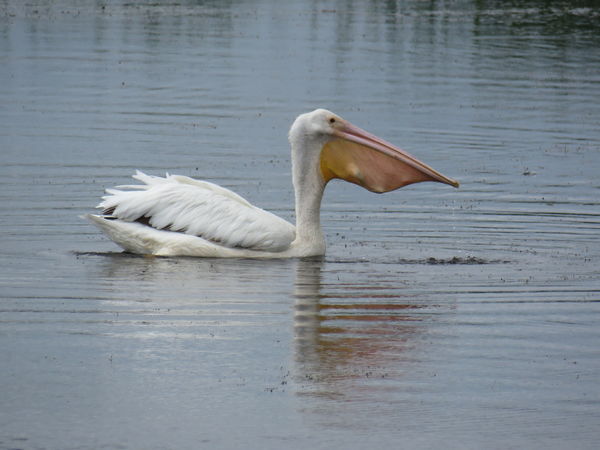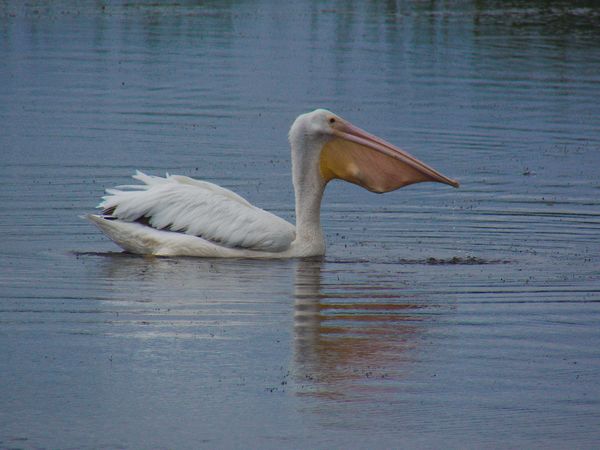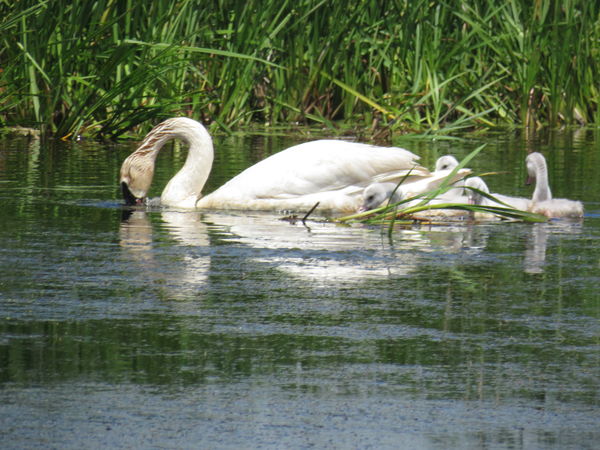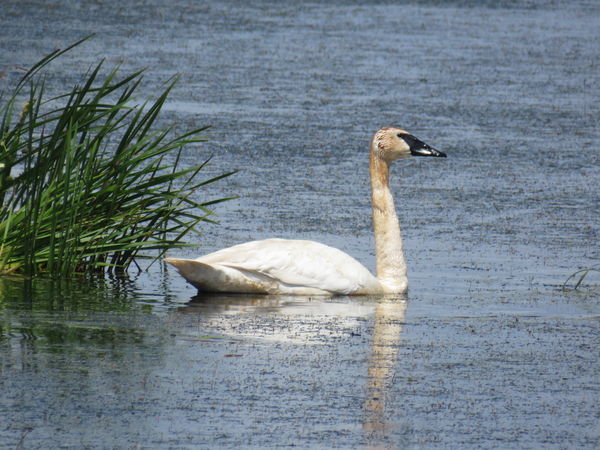ISO again
Jul 20, 2017 16:54:23 #
I almost hesitate to post for fear of inciting a flame war... but then fireworks can be fun, so here goes (hoping nobody gets too badly burned).
When I got my first digital I used ISO at 100 or 200... lesson learned from film, and I saw no reason to differ. As I've tried to master my current camera I've done a tremendous amount of reading and searching, and found huge amounts of (often contradictory) information. One post I read recently (WISH I could remember the site!) suggested that since digital cameras have improved so much lately there is no longer a need to constrain ISO so much... or maybe at all... and suggested setting ISO auto and let the camera go.
On a recent trip to a wildlife sanctuary I decided to try this theory, and took several shots of pelicans and swans that I thought were quite good, and I submitted one (pelican 1) to Shutterstock - where I have a couple of other photos accepted. It was rejected: "Focus -- The main subject of this image is not in focus". I tried to sharpen it using Corel AfterShot and resubmitted (pelican 2), getting rejected again: "Noise / Artifacts / Film Grain -- Image contains excessive noise, film grain, compression artifacts".
I wonder whether the free-range ISO I was using could be a causative factor in all this - why pelicans 1 and 2 didn't fly :)
I also attach for purposes of comparison a couple of other shots taken in the same few minute-span, using the same camera settings (swan 1 and swan 2) - these straight out of the camera with no PP.
I will read with great interest opinions on (1) using auto-ISO versus tightly constraining it, and (2) whether the high ISO caused the rejection of (pelican 2) following PP.
Thank you.
When I got my first digital I used ISO at 100 or 200... lesson learned from film, and I saw no reason to differ. As I've tried to master my current camera I've done a tremendous amount of reading and searching, and found huge amounts of (often contradictory) information. One post I read recently (WISH I could remember the site!) suggested that since digital cameras have improved so much lately there is no longer a need to constrain ISO so much... or maybe at all... and suggested setting ISO auto and let the camera go.
On a recent trip to a wildlife sanctuary I decided to try this theory, and took several shots of pelicans and swans that I thought were quite good, and I submitted one (pelican 1) to Shutterstock - where I have a couple of other photos accepted. It was rejected: "Focus -- The main subject of this image is not in focus". I tried to sharpen it using Corel AfterShot and resubmitted (pelican 2), getting rejected again: "Noise / Artifacts / Film Grain -- Image contains excessive noise, film grain, compression artifacts".
I wonder whether the free-range ISO I was using could be a causative factor in all this - why pelicans 1 and 2 didn't fly :)
I also attach for purposes of comparison a couple of other shots taken in the same few minute-span, using the same camera settings (swan 1 and swan 2) - these straight out of the camera with no PP.
I will read with great interest opinions on (1) using auto-ISO versus tightly constraining it, and (2) whether the high ISO caused the rejection of (pelican 2) following PP.
Thank you.
Jul 20, 2017 17:18:02 #
Personally, I only use auto ISO when I'm in full blown snap shot mode. Any other time I set the ISO accordingly based on the available light, lens and subject.
If you can shoot at ISO 100 or 200 most of the time then by all means, do it. I don't know what camera you have but I know with a few of my cameras, I can go pretty high in the ISO range and still get acceptable photos. It depends on the conditions you have to work with and what you determine as acceptable.
Some of todays newer cameras are capable of doing an amazing job of masking or eliminating digital noise.
As for your photos, there is digital noise in the images but I couldn't truly judge them without seeing an actual print. The image is only as good as the device it's being viewed on.
If you can shoot at ISO 100 or 200 most of the time then by all means, do it. I don't know what camera you have but I know with a few of my cameras, I can go pretty high in the ISO range and still get acceptable photos. It depends on the conditions you have to work with and what you determine as acceptable.
Some of todays newer cameras are capable of doing an amazing job of masking or eliminating digital noise.
As for your photos, there is digital noise in the images but I couldn't truly judge them without seeing an actual print. The image is only as good as the device it's being viewed on.
Jul 20, 2017 17:57:43 #
I wondered why you would need a very high ISO for daylight photos, and then checked the EXIF and saw the Pelican was shot at 200. I don't know why it would be so noisy at that ISO. I'll bet the increased noise in Pelican 2 was caused by your attempt to sharpen the photo. You can't digitally sharpen out of focus shots.
The high ISO performance of the latest digital cameras has improved greatly from the earlier models, and it probably the one area where digital cameras are clearly superior to film. But you still don't want to use a higher ISO than is necessary to get the highest shutter speed and smallest aperture absolutely necessary to accomplish the goals for your photo.
The high ISO performance of the latest digital cameras has improved greatly from the earlier models, and it probably the one area where digital cameras are clearly superior to film. But you still don't want to use a higher ISO than is necessary to get the highest shutter speed and smallest aperture absolutely necessary to accomplish the goals for your photo.
Jul 20, 2017 18:00:27 #
I downloaded pelican 1 and pelican 2 so I could see the metadata. This is what I see for pelican 1 (the metadata seems to have been stripped out in pelican 2).
Canon PowerShot SX60 HS (16.1 megapixels)
F-stop: f/8
Exposure time: 1/500 sec.
ISO speed: ISO 200
Exposure bias: 0 step
Focal length: 247mm
Max aperture: 5.4
Metering mode: Pattern
The ISO was only 200 so that would not be a factor. Even high ISO wouldn't cause the photo to be soft although digital noise would creep in. Your shutter speed was 1/500 sec. which is fast enough for that shot. I think your camera didn't achieve good focus or the lens has soft image quality. Nothing in the photo is sharp from front to back.
Canon PowerShot SX60 HS (16.1 megapixels)
F-stop: f/8
Exposure time: 1/500 sec.
ISO speed: ISO 200
Exposure bias: 0 step
Focal length: 247mm
Max aperture: 5.4
Metering mode: Pattern
The ISO was only 200 so that would not be a factor. Even high ISO wouldn't cause the photo to be soft although digital noise would creep in. Your shutter speed was 1/500 sec. which is fast enough for that shot. I think your camera didn't achieve good focus or the lens has soft image quality. Nothing in the photo is sharp from front to back.
Jul 20, 2017 18:06:51 #
Your camera chose the correct ISO. 200 ISO is low. Your images have other issues, focus being one of them. I think you may have over-sharpened your resubmissions. I have a focus issue because of shaky older hands and I have to be very careful not to get motion blur. I am not saying that is the cause of the focus issues, only that coupled with a camera not made for low light conditions can cause problems. What sort of light conditions did you have?
Jul 20, 2017 18:12:20 #
Are these heavily cropped?
While it is not the cause of your problem, todays cameras do provide better results with higher ISO than older cameras. But each model has to be judged on it's own. The high ends listed in most specs are a dream if you want good results. But 5,000+ is doable on some cameras.
--
--
While it is not the cause of your problem, todays cameras do provide better results with higher ISO than older cameras. But each model has to be judged on it's own. The high ends listed in most specs are a dream if you want good results. But 5,000+ is doable on some cameras.
--
--
Jul 20, 2017 18:16:26 #
Bill_de wrote:
Are these heavily cropped?
--
--
The camera is 16.1 megapixels and the image dimensions are 4608 x 3456. It looks like they were not cropped or just slight amount.
Jul 20, 2017 18:21:11 #
The problem is that all the images are WAY out of focus - when you sharpen them, you exaggerate the noise and make it far worse than in the original.
Jul 20, 2017 18:24:44 #
This is a good example of the gear producing a subpar image. The settings all seem to be correct, exposure is fine and the image comes out like this. Sometimes gear matters and I think this is a good example of that. Some here hesitate to blame the gear but that was the limiting factor in this case. As said before nothing seems sharp but it was probably in focus. The optics did the best they could but it was not enough.
Jul 20, 2017 19:59:14 #
I think the 247mm in the EXIF is the actual focal length and not the 35mm equivalent. The 35mm equivalent is 1365mm and the shutter speed of 1/500 isn't sufficient. I personally never could get good images out of those super zoom cameras when using the long zoom.
Jul 20, 2017 20:02:18 #
You might have tried f11 with better results (changing ISO or shutter) and do some test shots to check the sharpness of the lens.
Jul 20, 2017 20:11:04 #
robinboulton wrote:
I almost hesitate to post for fear of inciting a f... (show quote)
Based on the metadata, you are probably getting the best out of this camera. Shutterstock is not wrong - these images are unacceptably soft. Also, as a matter of what is considered good practice - there is a lot of "crud"
on the water that is quite distracting and should be cleaned up. The image of the swan is off level, and slightly blown out.
This review provides some examples at high magnification and ISO 200 that don't look all that different from yours.
https://www.cameralabs.com/canon_powershot_sx60_hs/2/
Jul 20, 2017 20:31:57 #
chaman wrote:
This is a good example of the gear producing a subpar image. The settings all seem to be correct, exposure is fine and the image comes out like this. Sometimes gear matters and I think this is a good example of that. Some here hesitate to blame the gear but that was the limiting factor in this case. As said before nothing seems sharp but it was probably in focus. The optics did the best they could but it was not enough.
The ISO is okay. Unfortunately, I think these photos just show the limitations of the Canon SX60 when used at maximum focal length. Backing off the max focal length might improve image quality a little bit. But a bridge camera is not going to give DSLR results.
Jul 20, 2017 20:42:26 #
The SX-60 has a 1/2.3" sensor. That type of sensor has a crop-factor of 5.6; that is, it is slightly larger than 1/4-th the size of an APS-C sensor in each dimension. My Pentax Q-7, which has a 1/1.7" sensor, maybe 20% larger than the 1/2.3" sensor in each dimension, starts struggling around ISO=400; the images are fine, but not very stable, having latent noise which is not so obvious but is "just below the surface", so I'm guessing SX-60 images could start having issues at ISO=200. In this case, sharpening pushed this "not very stable" image over the edge, bringing out latent noise that was just below the surface.
Jul 20, 2017 23:02:43 #
rehess wrote:
The SX-60 has a 1/2.3" sensor. That type of s... (show quote)
Additional comments{too late to edit my previous post}
In several discussions here, Canon users have expressed concerns about the SX-60, many saying they would rather have an SX-50. There may be issues with the lens built into the SX-60, and what we are seeing in Swan1 may be a result of those issues, in this case appearing as uneven focusing.
In any case, I kind of doubt that a bridge camera will consistently provide the IQ expected of stock photos.
If you want to reply, then register here. Registration is free and your account is created instantly, so you can post right away.














